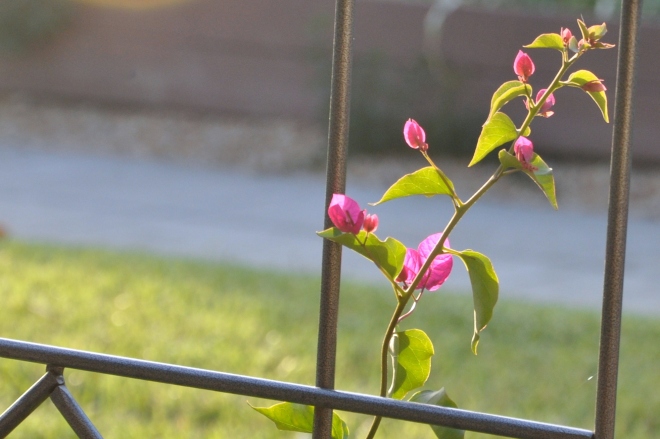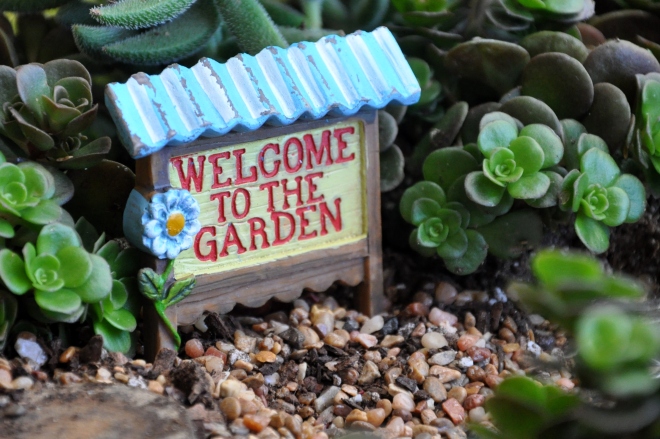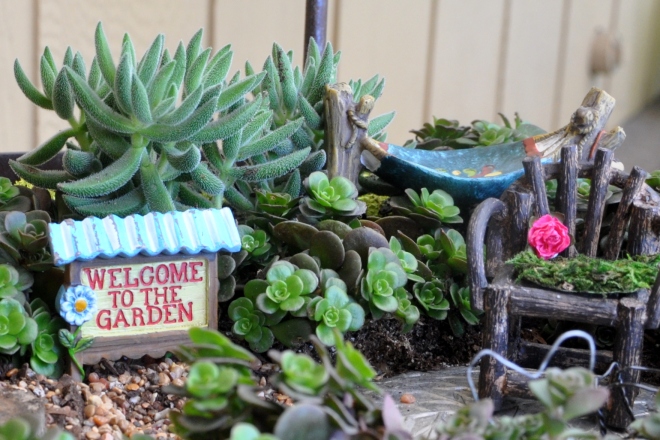I’m gradually turning our garden into a more sustainable oasis. Instead of nurturing the English garden of my dreams, I’m letting nature do the talking. I’ve learned a lot from four years of drought.
We’re no longer watering our lawn, allowing nature to takes its course. I met with a landscape designer a few weeks ago and he’s putting together a design for native perennials. I’m envisioning a small meadow that attracts native birds and insects.
Last week I submitted an application to the Santa Clara Valley Water District’s Water Conservation Unit. It will take five to seven weeks to process a one page request, but so it goes with many government agencies. That in turn will generate a lengthy packet of materials to complete, and only then can we proceed (if we want to receive a rebate). As the drought drags on, the rebates increased. Original rebates offered seventy-five cents per square foot. They’ve now increased to $2 per square foot for:
converting high water using landscape (i.e. irrigated turf or functional swimming pool) to low water using landscape. These increases are temporary, through December 31, 2015, and certain restrictions apply
Our back lawn is 370 square feet. If approved we’ll receive a $740 rebate. The front lawn is a bit larger so all told, getting this approval will put a nice dent in the conversion costs. With or without the rebate, we’re going forward with the plans.
In addition to converting the lawn into native landscaping, I’m no longer filling pots with annuals. We have three large pots on the deck that receive irrigation from a drip line. Everything that was hand-watered is gone or replaced with succulents that get by on virtually no water at all.
Welcome to the Garden
Late yesterday, just before sitting down to write my fairy garden post, I received an out-of-the-blue package from my friend Kristi. Along with her lovely note she sent these charming fairy garden treasures. I wasted no time adding them to the garden. I adore that little sign!
I tucked the new hammock among the soft greenery. It’s the perfect napping place and makes me wish I was Thumbelina. Thank you, Kristi!






Kristi’s gift is beautiful – and just perfect for your new garden! Good luck with the rebate! It has just occurred to me that it must be quite challenging for those without extra means to even consider changing/improving their gardens to meet the current crisis. One of the great pluses with succulents is they can be so easily propagated to spread around with no extra cost involved – I see a Little Free Succulent Garden in your future!! 🙂
LikeLiked by 1 person
Oh I love that idea of a little free succulent garden. You are full of clever ideas today.
They do spread easily, don’t they?
It can be quite costly replacing a lawn, especially if you install a drip system in place. Replacing a pool is even worse. And how is this for a kicker: if you have an empty pool on your property, you can’t get a mortgage loan. But if it is empty, you aren’t currently allowed to fill it. Pool owners are allowed to top off up to a foot but no more. If you take a pool out, you have to disclose that when you sell your property. The average cost of removing and filling in a pool around here is $10 – $12,000. You can’t build on the site, but you can landscape.
Using that model, a 500 square foot pool would be eligible for a $1,000 rebate.
LikeLiked by 1 person
And pools of course were once considered items of necessity in your part of the world weren’t they? What a dreadful conundrum to be faced with now! It seems California is leading the way in reeducating how we must think about living now. I bet all the non-pool owners are thanking their lucky stars they never could afford to put one in. 🙂
I can so see you running a little free succulent exchange programme 🙂
LikeLike
Yes. I was just reading that they were part of the ‘American dream’: a two-car garage and a pool outback. Funny, eh? Now that some of her communities are changing culturally, it’s considered bad fung shui to have a pool outback so they’re even less desirable. We’ve been very lucky to live a block from a pool that we can join each summer. It was great when the boys were young, the best of both worlds: access to a pool without the cost of insurance and maintenance, not to mention all the safety issues.
Since I’m not much of a swimmer and can burn to a crisp in 15 minutes, pools were never high on my list, but I know others that love it. My sister Sharon swims at the YMCA seven days a week, one of the best things for the stiffness that comes with MS. They have a lifeguard on duty and showers and lockers for the disabled. She even gets a discount on her monthly membership based on need.
The succulent exchange. I’ll get a little cart and roam the neighborhood with a wide-brimmed hat. 🙂
LikeLike
😀
LikeLiked by 1 person
I’m beginning to wish I was a fairy in your garden! The hammock is so very cute! On reading how you are cutting back on watering this summer I realize how lucky I am to be able to water my summer containers and to grow annuals. I have learned to be indifferent about many plants that will not grow in the conditions I can offer, be it due to the cold winters, hot summers or slugs and snails… And have grown to love what I can grow. I do hope that happens for you too Alys, and you develop a love for succulents and grasses that can cope with drought. Good luck with the changes. (And the rebate!)
LikeLike
Cathy, I’ve just come from your spice organizing post. Congratulations on a job well done. You have the neatest printing, too. It all looks terrific.
Yes, there are days when I too would like to be a carefree fairy. That said, life is pretty good and I have no major complaints. 🙂
I’m inspired by what you’ve said about your garden. Funny what you said about snails too because, with the exception of basil which I hide under a screen from the snails, I try to plant things the snails don’t like. I feel a real paradigm shift, and an understanding that I can enjoy gardening just as much with natives as with anything else, perhaps even more so knowing that I’m doing what’s right for the environment.
Thank you, Cathy!
LikeLike
I second Cathy’s comments! I bet the garden turns out beautifully.
LikeLiked by 1 person
Thank you!!! I appreciate the support.
LikeLiked by 1 person
That fairy garden looks like heaven
LikeLike
Feel free to send any fairies you see my way. 🙂
LikeLike
Oh sorry i keep them in my fairy garden perhaps we can share
LikeLike
🙂 I think of them as free spirits, so I’ll leave them to flutter about and do what fairies do best: help us engage our imagination. Deal?
LikeLiked by 1 person
Deal
LikeLiked by 1 person
Alys, good luck converting your garden. Seeing the drought maps for CA has been an eye-opener for me.
LikeLike
Thank you so much! Those maps, along with photos of our reservoirs, are sobering. Not knowing when the situation might change is unsettling as well.
LikeLike
The Italian government doesn’t do anything like that and also sets a bad example by allowing local councils to plant and irrigate grass on rounderbouts and other spaces; worse most of the time the irrigation isn’t checked and most is sprayed over the roads and runs into the gutters. Hope your plans work out. Christina
LikeLike
They are setting a terrible example, and recklessly spending tax payers money to boot. There are strict fines going into place here June 15th for over-spraying a garden, washing your car at home (instead of at the car wash which uses reclaimed water) or using your hose to wash down the sidewalk or drive. We can only water two days a week, before 9 am and after 8 pm. We’re receiving an allotment of water which will amount to using 30% less than what we used two years ago and the rates will double if you overuse your quota. They’re quite serious.
Thanks for sharing your perspectives. I love hearing how things are done in different parts of the world. We have a lot to learn here as well. I often wish we could combine best practices from around the world and apply them to everything: health care, education, environment, homelessness. I know there are answers.
LikeLiked by 1 person
Such charming wee gifts for the fairy garden, and thank you for reminding me about Thumbelina.
LikeLike
Here’s the funny thing: I hadn’t thought about Thumbelina in years, but as I was writing that paragraph, she popped into my head. I loved books like that as a girl. It was funny to revisit some of the Google images of the stories,too.
LikeLiked by 1 person
I must look up some of them too. Thumbelina was one of my favourite stories, mainly because of the illustrations .
LikeLike
Children’s illustrators are remarkable. I used to want to crawl into the pages of some of those books. I loved all the details: the flowers and trees, small animals, quaint houses. So charming and imaginative.
LikeLiked by 1 person
Indeed. 🙂
LikeLike
I loved Thumbelina, too!! She would’ve felt right at home in your teeny garden! It’s interesting to hear you talk about changing your lawn and garden. I think we all tend to try to make something of our gardens that perhaps they weren’t meant to be–green grass where sand beach is what nature wants, tropical-type flowers where it’s simply too cold. The rest of us could learn a lot from California’s forced changes–learn to work with Mother Nature, instead of against her!
LikeLike
Interesting post… Good on you for thinking laterally. I think there will be less heartbreak with a garden that suits your current climate.
LikeLike
Helen, you are so right. Thank you!
LikeLiked by 1 person
I almost missed this! I love your new additions to the fairy garden and I love the new plan. I think it’s wonderful if the city will give you a little something to convert your yard. This has been an expensive project for me but I’m doing it for other reasons; to make the yard more manageable. We are going to be hotter and dryer this year too. It’s a cycle but not a very pleasant one. Wonder if anyone knows when the cycle will end.:( Have a wonderful weekend and keep cool. Hugs
LikeLike
Thank you, Marlene. You are wise to convert your garden into something you can both enjoy and maintain. I used to mow our lawn every weekend, and trim the edges twice a month. It got harder and harder to keep up with two small boys (I had a push mower) so we eventually hired a service to cut the grass. I’ve realized now how liberating it will be not to have a lawn in addition to all the other benefits.
I can’t wait to see the remaining projects you have underway. Everything I’ve seen so far looks terrific.
LikeLiked by 1 person
Ah, but the camera can hide the story as well as tell it. There is such a mess going on out there until I get back to it. This morning looks good. I’ll be back at it. Spent Monday cleaning house for a friend that didn’t make it, Tues picking up the car from the dealer, it’s old and lots of things are going wrong, as well as taking in my laptop for the second time in a week because it wouldn’t charge. Finally got them to order a new power pack. Still under warranty. Today is our last cool day so I will get outside work done. I saw a book on none mow lawns. May look into it.
LikeLike
Cars and computers: please just make them go. (That was my inner voice talking). Seriously, they can drive you nuts, yet we’re lost without them.
I hope I didn’t misunderstand the comment about cleaning house for a friend that ‘didn’t make it.’ Have you lost a dear friend?
LikeLiked by 1 person
No, she was a no show as usual. At the last minute she can never quite make it to my house, again..Sorry. Didn’t mean to scare you. She was bringing the little one so I wanted everything extra clean since I’m sure he’s crawling now. 😦 It’s an old habit of hers.
LikeLike
Ah…thanks for clarifying, but sorry she was a no show, and without explanation either. That’s a tough one.
LikeLiked by 1 person
She was tired…
LikeLike
An ‘always something’ friend, that is perhaps not sensitive enough to understand the impact her decisions make on others.
LikeLiked by 1 person
She’s young. Lots to learn. 😦
LikeLike
You’re a good soul, and a good teacher too.
LikeLiked by 1 person
PS
xoxooxoxoxoxoxooxoxox
LikeLiked by 1 person
PS Hard to know when the cycle will end. I hope this isn’t a new normal.
LikeLike
I’ve been doing a bit of reading on it. They are talking about 20-30 years. There is a lot involved and I don’t see relief anytime soon. We are expecting temps in the mid 90’s this weekend after several days in the 60’s. I don’t remember 90’s this early in the summer here. We’ve already had one round. I was laughing with my son and said I’d do the snow bird thing and go to Australia every summer and enjoy their winter. If wishes were horses….
LikeLike
Ugh! 20 to 30 years is a long, long time. 90’s does sound hot for your area. We’ve had every variation of weather oddities this year, that I no longer know what to expect. It’s hot when it should be cold, mild when it should be wet, and dry, dry, dry. I miss the rain so much. Let’s grab a horse and fly to Australia together. We can be just as unpredictable as the weather.
LikeLiked by 1 person
I’d love it. I’m very predictable. 😦 I was reading something about sun bursts having something to do with the weather changes but can’t find the link again.
LikeLike
Hmmm…interesting. That sort of thing happens to me a lot. I read things here and there, but then I can’t seem to relocate them. Too many places to look: was it the paper, a blog, Facebook, overheard in the store. The list goes on and on.
LikeLiked by 1 person
Alys, I read all the comments and your replies with interest. I had not yet heard about the quota – is that state-wide? And to whom does it apply? I read a while ago that something like 90% of the water usage in CA is attributable to agriculture. There’s a conundrum – reduce water usage for crops and that will damage the yield and negatively impact prices and the economy. No easy solution. Very scary situation all around. I applaud you for doing what you can at your own level.
LikeLike
Stacy, the water conservation decisions are in constant flux. It’s a wonder anyone knows what’s going on. Governor Brown has declared an across the board, 30% mandatory cut, but left it up to the cities and counties to determine how. San Jose Water provides water for our area. They sent out a letter saying that as of mid-June we would have to reduce our water usage to 30% of what we were using in 2013. If you use in excess of your allotment, you can be fined, with increasing fines for scoflaws. Further, going over your allottment more than doubles the base rate per CF.
And you’re right, California is a huge agricultural state with the majority of our water going to industry and agriculture. Even worse, some of these industries have been tapping into ground water reserves making matters worse.
Check this out: So a single egg takes 53 gallons of water to produce. A pound of chicken, 468 gallons. A gallon of milk, 880 gallons. And a pound of beef, 1,800 gallons of water. (Of course, these figures are all approximate, and estimates differ. These are based on data from the Pacific Institute and National Geographic.)
You can also calculate your own water footprint at National Geographic’s website.
LikeLiked by 1 person
Wow, Alys, those figures are staggering!! I am intrigued by the ability to calculate my own footprint and will definitely visit Nat Geo’s site. 30% is a huge cut and one probably not easily met. This reduction will only work, though, if the fines are actually levied. Do you have any idea what these excess funds will be used for? I’m hoping it doesn’t just go into the general coffers but rather is earmarked for water conservation development. As for leaving it up to individual jurisdictions, it will be interesting to learn what LA county plans to do.
LikeLike
I took the quiz today. It’s amazing the water used to raise cattle, pork and chicken. I’m glad to know being a vegetarian means I’m making a difference in that way. The only appliance we can improve on is a front loading washing machine. They’re much more efficient, thought the washer we do have has several water-saving features. We have low flow toilets, an energy efficient dishwasher, and aerators on all our faucets. The lawn is on the way out, and I’ve emptied all the pots or replaced the annuals with succulents. Little by little, our outdoor use is improving.
Today our paper said that as a whole, we only cut back by 13% in April. We have a long way to go. I’ll let you know what I learn about LA, fines, etc.
LikeLike